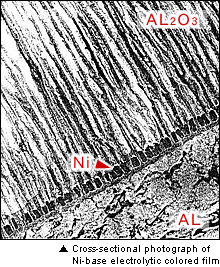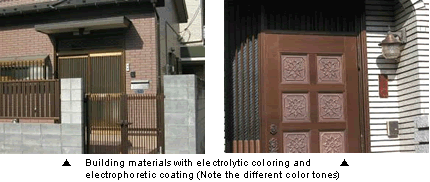Functional alumite (functional anodic oxide coatings)
Traditionally, Anodic oxide coatings have been used to provide aesthetic, corrosion resistant, and wear resistant properties to aluminum products. Recently provided via micropores with the various functions of wear resistance, lubricity, magnetism, and conductivity, these coatings are attracting attention as new functional materials.
Hard alumite
Aluminum and its alloys are characteristically light in weight, moderate in price, and excellent in workability. The disadvantages are low surface hardness and proneness to scratches and wear. Standard alumite coatings are sufficiently effective against light loads, while hard alumite coatings are necessary to protect against high loads.
Hard almite (Hard anodic oxide coatings) are by no means special functional anodic oxide coatings. Rather, the former are extensions of the latter, but with an emphasis on hardness (Hv 300 or higher) and thickness (normally 30 μm or more). A typical overall classification of anodic oxide coatings according to hardness would be as shown in Table 1.
[Table 1] Classification of functional anodic oxide coatings by hardness
|
Table 2 shows typical hard alumite surface treatment conditions:
[Table 2] Hard alumite electrolytic conditions
|
These characteristics can be paraphrased as follows:
(1) Electrolytic baths
Typical industrial electrolytic baths include sulfuric acid baths, sulfuric and oxalic acid baths (mixed acid baths), and oxalic acid baths. There are also additional industrial electrolytic baths available, such as inorganic acid baths, organic acid baths, and aromatic sulfonic acid baths.
(2) Bath temperatures
Usually, alumite surface treatment is performed at around 20°C. Hard alumite surface treatment is generally performed at a low temperature of around 0°C. This is because low temperatures increase the coating hardness.
(3) Current density
The intensity of current flow during electrolysis is usually expressed as the current density per unit area (A/dm2). In electrolytic surface treatment, hard alumite is electrolyzed at a current density twice to five times that of standard alumite. This is done to minimize the coating formation time and to prevent the coating from dissolving in the electrolyte.
(4) Agitation and cooling
The bath voltage increases at higher electrolytic current densities. Lower temperatures also increase the bath voltage. Consequently, the power input to the electrolytic bath also becomes large, generating a great amount of heat. As a countermeasure, a cooling device is necessary that agitates the electrolyte to disperse and rapidly remove the generated heat from the work surface.
(5) Special current waveform
High-hardness coatings are usually produced by direct current electrolysis or alternatively by special waveform current electrolysis at relatively high temperatures.



